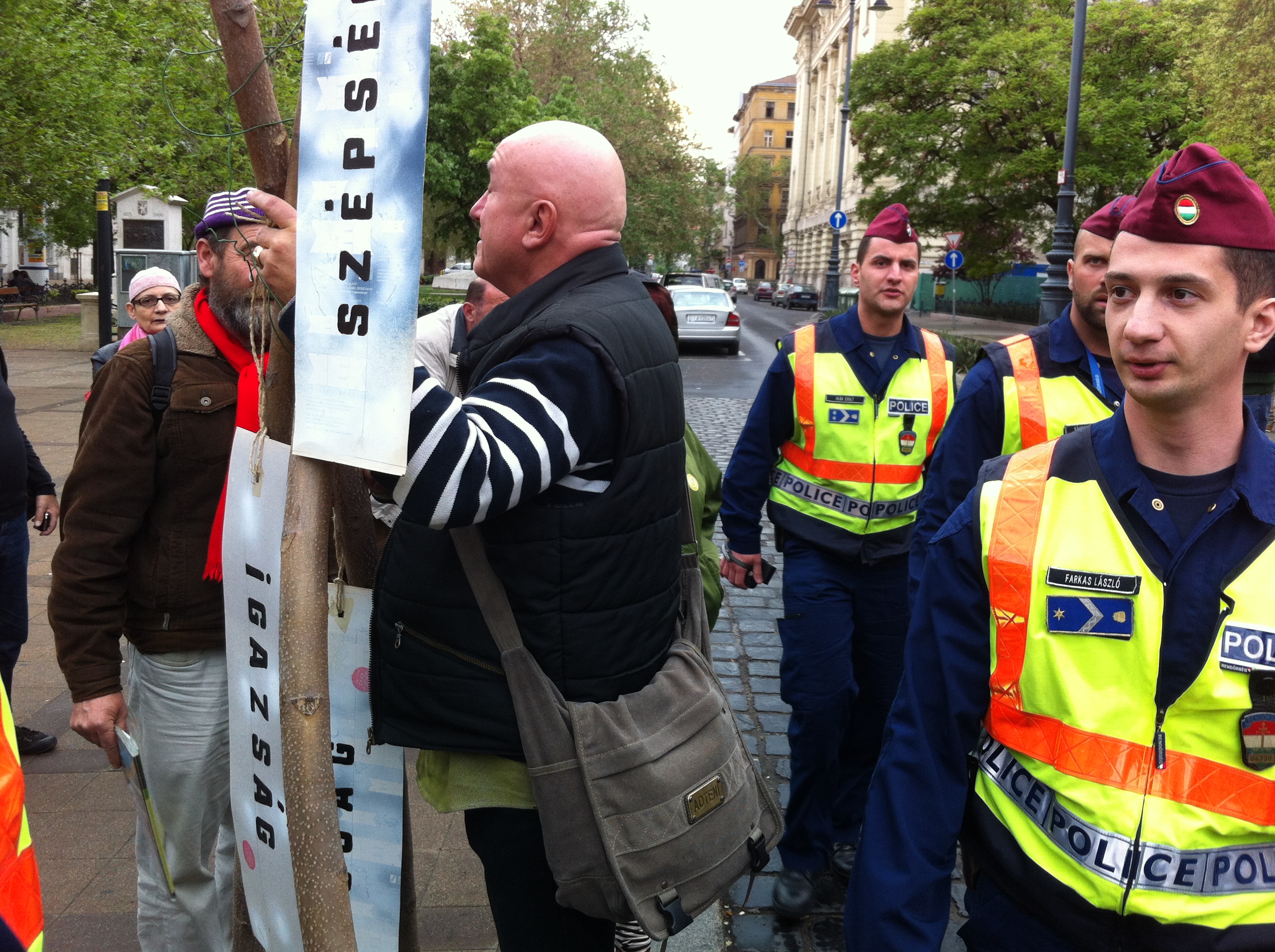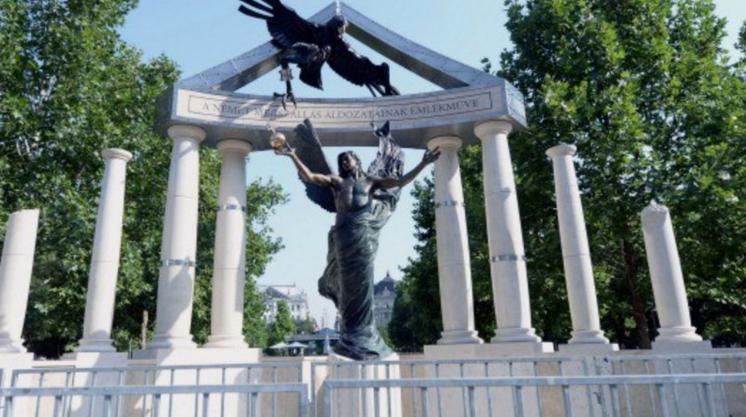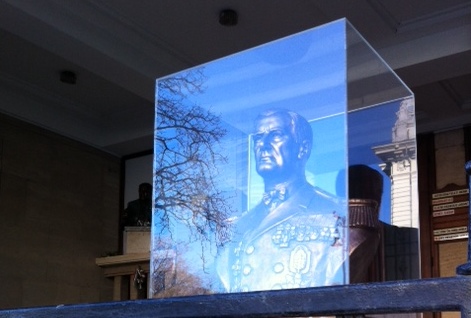
Walking home today from an Easter Monday walk in Budapest, we unexpectedly came upon an artist, Tibor Szilagyi, trying to challenge the government’s “Germany Made Us Do It” statue project in Freedom Square. Tibor wanted to protest the government’s planned statue, which aims to absolve Hungarians from any Holocaust guilt.
Tibor’s art installation was three large tree branches formed into a “tree,” each carrying one word written on a white streamer: “beauty,” “truth” and “goodness.” Two police stood warily nearby, guarding the site. This has been a confusing assignment for them. Every day the government’s workmen try to build up the base of the statue, and every day Hungarian protesters politely deconstruct it piece by piece. The police video this illegal activity, but aren’t arresting people yet. They wait and watch as people like Tibor work to create a counter-message on the site, one that seeks to honor the 560,000 Jews, Roma and other innocents killed almost entirely by fellow Hungarians during World War 2. Hungary was Germany’s ally until near the end, when the government tried to change sides, as they saw the Axis losing the war.
Some, like Prime Minister Viktor Orban, argue that Hungary had no choice, because if it didn’t ally with Germany from the beginning, it would have been invaded, like Czechoslovakia, and the Jews would have been killed sooner. Hungarian Regent Miklos Horthy tried to protect the Jews, under this interpretation, and nearly succeeded until the end of the war, when the Germans marched in to Budapest, rounded them up and send them to Auschwitz. But this account overlooks the decades of official Hungarian anti-Semitic laws and activities, including willing Hungarian complicity throughout the war in creating Jewish and Roma slave labor camps where thousands died, episodes of rounding up Jews from the countryside, and killing them; and the wholesale theft of Jewish businesses, property and jobs well before the Germans took over in 1944. Hungary allied with Germany in World War Two to get back the lands it lost the last time they joined together, as allies in World War One. In the end, it was Hungarians who shipped the Jews off to the death camps, or tied them together and shot them into the Danube in 1944. Only about 200 German troops were in Budapest at the time.
We were amazed to see how, in front of Tibor’s “tree,” the embattled scaffolding for the government’s statue has become a beautiful protest memorial of handmade signs, pictures, stones, and candles to honor the Holocaust dead. Someone placed two empty white chairs facing each other, to represent the lack of dialogue in Hungary about this painful history. Hungarians’ real roles are not discussed openly or honestly in most official textbooks; Holocaust guilt is not a widespread source of concern here. But the Fidesz government, to promote nationalist pride, has gone too far now, blaming Hungary’s German allies for everything that happened.
Tibor was taking the makeshift Freedom Square anti- memorial to a new level. The police decided today to call in reinforcements. Soon there were eight uniformed officers huddling around the artist. He smiled and chatted with passersby, while the officers looked puzzled about what to do. We were delighted to see the U.S. Charge D’Affaires, Andre Goodfriend, taking pictures of the scene and inquiring about what was going on.
We all took pictures, and, sensing that there was no violent confrontation in store, went home. If this shows up in the news here tomorrow, it will almost certainly be about a troublemaker who wanted to erect an illegal monument and disrupt the civil order. And it could well be about foreigners who don’t want Hungarians to be proud.
I hope Tibor is proud, and I would like to respect the pride of all Hungarians. But that would require that these whitewashing official historians face the truth honestly. That is the only way to build a future that can’t be torn down, plank by plank, every time a new government comes to power.

Today officially marks the 70th anniversary of the Hungarian holocaust. A few Hungarian government officials will put flowers by the Danube, where hundreds of Jews were tied together and ordered to take off their shoes. Only the first and last in the line were shot, but the rest, who were lashed to them, died by drowning as they were all pushed into the river. That way the Hungarian Arrow Cross government could save bullets.
Last night I watched as ordinary Hungarians, old and young, Jewish, Christian, dark, light, men, women, and children, worked nearby to stop the construction of a new statue in my Budapest neighborhood. This monument is a personal project of Prime Minister Viktor Orban, to blame Germany for the 560,000 Jewish, Roma and other Hungarian Holocaust murders during World War II. The international community has protested this statue, which denies that Hungary was Hitler’s willing anti-Semitic ally throughout most of the war. This memorial aims to airbrush away the fact that it was Hungarians, not Germans, who carried out most of the official roundups and murders here, after decades of laws discriminating against Jews. https://www.youtube.com/watch?v=XpFHbKbCCzc
Much has been made of the far-right party Jobbik, which did gain more than 20% of the votes in the April 6 election. But they are the only effective opposition party these days, so many of their voters came to them despite their neo-Nazi ideology. I am more worried right now about Prime Minister Orban’s victorious Fidesz party. They have adopted many of the worst aspects of Jobbik, under the guise of a “center-right” approach, and they are playing with fire.
The government delayed the statue project briefly before the April 6 election, but Orban began construction a few hours after his victory was assured. If ever anyone had the capacity to be magnanimous, it is someone who has just won re-election with a contrived two-thirds supermajority. But apparently Orban is not in a generous mood. He remains unconcerned that he is creating a “soft” form of Holocaust denial in the heart of the bloodlands where it occurred. These unhappy historical facts get in the way of his signature effort to help Hungarians be proud of themselves. In Orban’s world view, whatever goes wrong here has been the fault of the Turks, the Germans, the Russians, and now, the liberal West. Orban loves to beat up the EU, which gave Hungary 24 billion more Euros in support from 2007-2013 than Hungary provided back—and the USA. Hungarians, seeing this narrative every day in their media, believe Europeans and Americans are actively plotting to deny them their birthright and their pride.
It is part of an ugly pattern that everyone here–especially here!–should resist. It was this same approach that German’s Hitler and Hungary’s Admiral Horthy used, to blame conspirators for their nations’ ills. While Germany has moved on, being exceptionally clear about acknowledging the mistakes of its past, today’s Hungary has done the opposite.
It is such a waste. Hungary, which boasts a traditionally well-educated and hard-working population, could yet become a strong and admired country. Its geographical and political location at the crossroads of East and West could make Viktor Orban a world leader, brokering needed peace and economic agreements among Iran, Russia, and the West. Instead Hungary has lost the respect of international businesses and governments who are looking for a sound economy, based on the rule of law and relatively honest work. Orban nationalizes and blames others for Hungary’s bad reputation in the West.
Viktor Orban, who once was a dissident against the Communists in 1989, and won a scholarship paid for by George Soros, could have won his recent election fairly, because many people here like him, and the opposition was such a mess. But international observers have concluded that his Fidesz party was able to capture the “supermajority” with only 44% of the popular vote because they changed the election laws to favor their districts, their candidates, media access, new diaspora absentee voters, and much more. http://krugman.blogs.nytimes.com/2014/02/28/hungary-an-election-in-question-part-5/
One couldn’t even find posters for the opposition candidates, whose television spots were also effectively barred from the airwaves before the April 6 vote. What we saw everywhere was prime minister’s ubiquitous portrait, with the phrase: “Viktor Orban, Hungary’s Prime Minister,” and another poster depicting the opposition figures as clowns. I even got a text message on my cell phone on election day, reminding me to vote for Orban. That would have been illegal, of course. As a foreigner, I am not registered to vote here. The government apparently seized the phone companies’ customer lists to push out its partisan message. Opposition candidates did not have that option.
The police today are shooting video of every person dismantling each plank and metal piece of the statue. Once they are arrested or subdued, it is likely that in a matter of days, the statue will be rushed to completion. This huge project will dominate Szabadsag Ter, “Freedom Square,” home of the US Embassy (where Cardinal Mindszenty found asylum from the Soviets after 1956), the Soviet obelisk (thanking the Russians for defeating the Germans in 1945), dwarfing a lifesize Ronald Reagan statue (thanking the USA for helping to defeat Communism) across the park. The dismantlers will gain nothing for this act of rebellion, but their souls. It is particularly outrageous that the monument’s construction is undertaken during not only Passover and Easter week, but the 70th anniversary week officially remembering the Hungarian Holocaust.
While they have little gain, these protesting Hungarians have a lot to lose. The Fidesz government now seems to have virtually unchecked power. To be sure, Hungary is in the European Union, but only barely. It is moving farther and farther away from democracy and a market economy. I could be depressed, watching this regressive behavior, the predictable election results and the mass media here, which are afraid or unwilling to tell the truth. But instead I am impressed, deeply impressed, with these other people who are taking real personal risks in a state that is creating a new era of intolerance and autocracy. They don’t know what the government will do to them, but they are willing to take their chances.
We foreigners are watching, and will bear full and loud witness to what happens next.

Hungary is struggling with how to remember the 70th anniversary of the Holocaust —when 560,000 Jewish and Roma Hungarians were assembled, robbed, tortured, and executed, most in an unprecedentedly fast four-month blitz at the end of the war. The attempted genocide was carried out by Hungarians—thanks to the governing Hungarian Arrow Cross party–and the nation’s German allies, at the very end of World War II. (http://www.ushmm.org/m/pdfs/Publication_OP_2010-01.pdf)
Many people here still don’t regard the Jews and Roma of Hungary as real Hungarians. So the seeds of that original disaster remain in the culture. The far-right Jobbik party actively campaigns on these themes, blaming them for Hungary’s stagnant economy. The ruling Fidesz party—which will win re-election in April—is more duplicitous about this, speaking out of both sides of Prime Minister Viktor Orban’s mouth. But lately Orban’s government has tipped the balance to the anti-Semitic, anti-Roma nationalistic side, hoping to steal Jobbik’s votes for their own Fidesz party in Hungary’s April 6 parliamentary elections.
Of course it isn’t easy, after all those years of Communism, to build a national economy that works. It’s even harder to create enough equity and mobility to inspire people to get a better education, take innovative risks, and build a safe and just community together. This requires accountability, and trust. These two qualities are hard to find in Hungary. Instead, the current political leaders like to blame some “outsiders” for conspiring “against the state” for their own gain. They say it is the Americans, the European Union, the socialist opposition, and, increasingly, it is the “Gypsies”, and the Jews. They are the reason the elected leaders cannot give you a decent life. These political leaders don’t seem to worry that are playing with fire; it’s not their responsibility to think about the Holocaust carried out by their relatives sixty years ago, in these very neighborhoods where I live and walk every day.
A recent visit to the Budapest Holocaust Memorial on Pava St. offered me the exact names, faces and fates of many of the people where were murdered by their countrymen during World War II. There are Hungarians living here today who looked the other way as their Jewish and Roma neighbors were carried off and murdered. Perhaps they even participated personally in the roundups. They had a lot to gain, especially the apartments and goods and jobs of the Jewish Hungarians, who were vital leaders of the Hungarian national culture and economy. In 1920, 22.7% of actors, 27.3% of writers and scientists, 17.6% of painters, 23.6% of musicians, 50.6% of lawyers, and 59.9% of physicians were Jewish, according to Yale historian Eva Balogh, who writes an anti-government blog, Hungarian Spectrum. Many of Budapest’s most admired buildings were designed by Jewish architects, but today’s school children are ignorant of these facts.
Even though the Hungarian government claims to be mobilizing the nation to remember the Holocaust under an international spotlight, there is no evidence of an honest discussion now in Hungary—or interest in showing school children the deserted memorial exhibit on Pava St.—to understand what happened, who did it, and how that could have been possible. This is in sharp contrast to Hungary’s ally in both world wars—Germany—which of course has always borne the greatest burden of guilt for the Holocaust, and has also done the best job of educating subsequent generations about the dangers of anti-Semitism, eugenics and race-based conspiracy theories.
A different history is being invented in Hungary these days, with new statues being erected in prominent locations, in order to exonerate Hungarians of any wrong-doing. The narrative is that brave Hungarians have always been the victims of outsiders—in the case of 1944, they now want to say it was all done by the Germans, plain and simple. There is a new statue, put up by a church that is officially sanctioned by the government, lionizing Hungarian Regent Miklos Horthy, who, they don’t care to mention, voluntarily allied Hungary with the Germans during World War II. (See the thumbnail picture of the Horthy statue at the top of this blog.)
The aristocratic Horthy, who presided over the laws robbing Jews of their property, jobs, and freedom to marry non-Jews, forcing them into slave labor, and causing the unnatural deaths of at least 60,000 Jews before 1944, has a contested legacy because of his attempt to change course in the final days of the war. He had entered into an alliance with Germany from the beginning, supporting the Nazis with soldiers, material, Jewish laborers, and propaganda, until they started to lose. In 1944, he tried to secretly withdraw Hungary from the Axis, but Germany found out, invaded Hungary, pushed him aside, and installed the more extreme Arrow Cross government. Together these Arrow Cross Hungarians and their German partners killed half a million Jews in the final four months of the war. A garden at the beautiful Dohany St. Synagogue—the second largest in the world—was originated after World War I to honor the Jews who had built the Hungarian nation and defended it during the war. In 1944 the garden instead became a mass grave for Hungary’s no longer “honored” Jews.
The statue of Horthy depicts him up as a nationalistic hero worthy of emulation. Now a second new statue–a project passionately put forward by Prime Minister Viktor Orban—will further depict the Hungarians as victims of the Germans. This fits well with the House of Terror museum, which Hungarian school children ARE taken to, in the former headquarters of both the Arrow Cross and the Communist secret police. There is a lot of blame here against the Allies who dismembered greater Hungary after World War I, against Communists, and against Germans. But there is no accountability here for what the Hungarian government did to its Jewish and Roma citizens during World War II, which is laid out in exquisite detail at the much less visited Pava Street memorial.
The good news is that there is international pushback against this second statue, which is an official project of the Orban government. Prominent Hungarian and American Jewish groups have withdrawn from the 70th anniversary Holocaust commemorations, and the controversy has stained the Orban regime. Hungarians who know him say that Orban is not himself an anti-Semite or even an anti-Roma racist; rather he finds it useful to stir up these nationalist emotions in order to further accumulate and exercise power.
Orban tries to have it both ways, deploying his EU-friendly cabinet officers to mollify the West, while actively funding anti-Semitic projects and people, winking as government-funded church schools re-segregate Roma children, and as government-supported apparatchiks rewrite the nation’s history. His government loses lawsuits and diplomatic skirmishes with the European Union, but nevertheless proceeds with impunity.
The most vulnerable and despised citizens in the Hungarian national narrative are the Roma (gypsy) people, who remain caught in a centuries-old complex dynamic of poverty, illiteracy and discrimination across Europe. The Hungarians have received millions of dollars from the European Union to help integrate their Roma population, which has lived here for over 400 years. The government has little to show for this investment. Here is a unique feature the Orban regime has introduced: if you declare officially that you are a member of the Roma minority, you are allowed on April 6 to vote ONLY for the Roma ticket—which features candidates only from Orban’s Fidesz ruling party.
A new report by my friend Magda Matache at Harvard’s FXB Center shows how anti-Roma violence is rising in Hungary. Zsolt Bayer–a racist who holds a top editorial job at a newspaper sanctioned by the Orban government , is a founding member of the Fidesz elite, a friend of Orban’s and a beneficiary of government funding–wrote in January 2013 that Roma are no better than animals, who do not deserve to live with the rest of us humans. Is this not what happened in the run-up to the Holocaust?
It is hard, in the face of all this, to live in this country. But even though I am a foreigner, I have found a way to stand up. I have sought out wonderful Hungarians who are working against these racist themes and practices. We have linked and energized each other with a project inspired by the Not In Our Town (www.niot.org) movement in the USA. We have had support from the US and Norwegian embassies, Central European University, and scores of Hungarian activist groups. ELTE social psychologist Gyorgy Csepeli, a prominent Hungarian scholar and public intellectual, is among those working with us to actively defuse the dangerous anti-Roma narrative. He is conducting workshops in towns around Hungary, talking people-to-people, trying to avoid the party politics that make honesty so difficult. Some times the Hungarian government is even on our side. It may be tokenism, but every bit of help is appreciated.



